四大发明英文版
中国古代四大发明中英文版17页文档
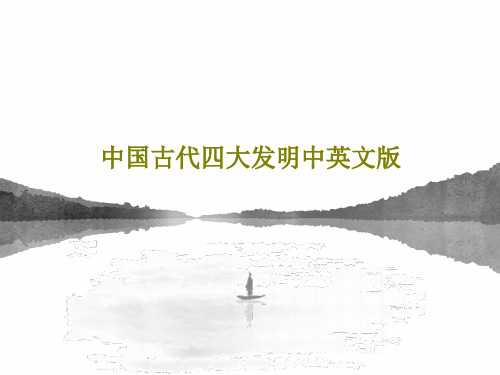
3、法律是最保险的头盔。——爱·科 克 4、一个国家如果纲纪不正,其国风一 定颓败 。—— 塞内加 5、法律不能使人人平等,但是在法律 面前人 人是平 等的。 ——波 洛克
谢谢你的阅读
❖ 知识就是财富 ❖ 丰富你的人生
71、既然我已经踏上这条道路,那么,任何东西都不应妨碍我沿着这条路走下去。——康德 72、家庭成为快乐的种子在外也不致成为障碍物但在旅行之际却是夜间的伴侣。——西塞罗 73、坚持意志伟大的事业需要始终不渝的精神。——伏尔泰 74、路漫漫其修道远,吾将上下而求索。——屈原 75、内外相应,言行相称。——韩非
四大发明简介(中英文版本)
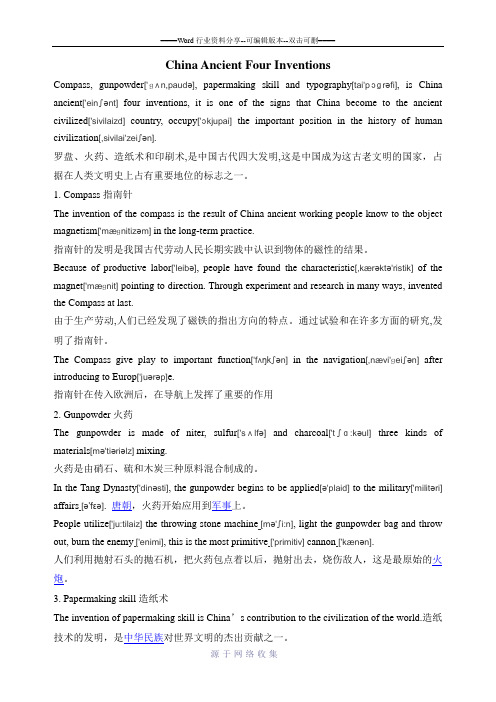
China Ancient Four InventionsCompass, gunpowder['ɡʌn,paudə], papermaking skill and typography[tai'pɔɡrəfi], is China ancient['einʃənt]four inventions, it is one of the signs that China become to the ancient civilized['sivilaizd]country, occupy['ɔkjupai]the important position in the history of human civilization[,sivilai'zeiʃən].罗盘、火药、造纸术和印刷术,是中国古代四大发明,这是中国成为这古老文明的国家,占据在人类文明史上占有重要地位的标志之一。
1. Compass指南针The invention of the compass is the result of China ancient working people know to the object magnetism['mæɡnitizəm] in the long-term practice.指南针的发明是我国古代劳动人民长期实践中认识到物体的磁性的结果。
Because of productive labor['leibə], people have found the characteristic[,kærəktə'ristik]of the magnet['mæɡnit] pointing to direction. Through experiment and research in many ways, invented the Compass at last.由于生产劳动,人们已经发现了磁铁的指出方向的特点。
四大发明简介(中英文版本)
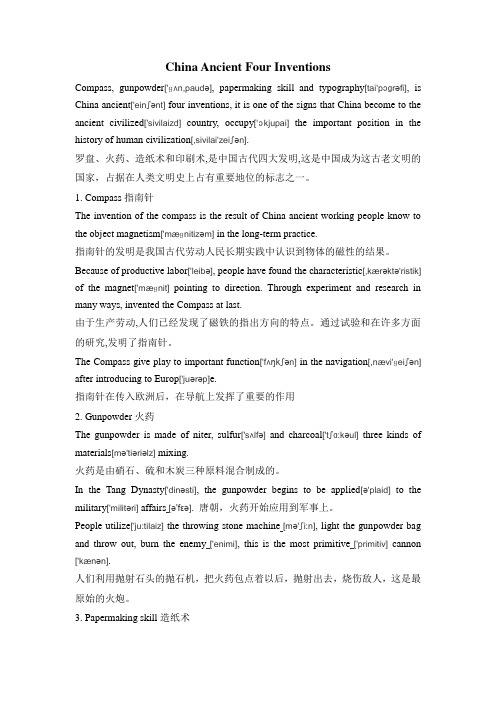
China Ancient Four InventionsCompass, gunpowder['ɡʌn,paudə], papermaking skill and typography[tai'pɔɡrəfi], is China ancient['einʃənt] four inventions, it is one of the signs that China become to the ancient civilized['sivilaizd]country, occupy['ɔkjupai]the important position in the history of human civilization[,sivilai'zeiʃən].罗盘、火药、造纸术和印刷术,是中国古代四大发明,这是中国成为这古老文明的国家,占据在人类文明史上占有重要地位的标志之一。
1. Compass指南针The invention of the compass is the result of China ancient working people know to the object magnetism['mæɡnitizəm] in the long-term practice.指南针的发明是我国古代劳动人民长期实践中认识到物体的磁性的结果。
Because of productive labor['leibə], people have found the characteristic[,kærəktə'ristik] of the magnet['mæɡnit]pointing to direction. Through experiment and research in many ways, invented the Compass at last.由于生产劳动,人们已经发现了磁铁的指出方向的特点。
中国古代四大发明 英语
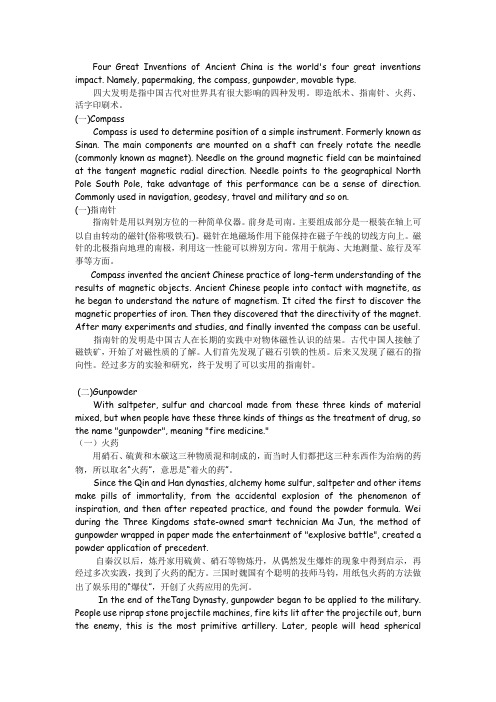
Four Great Inventions of Ancient China is the world's four great inventions impact. Namely, papermaking, the compass, gunpowder, movable type.四大发明是指中国古代对世界具有很大影响的四种发明。
即造纸术、指南针、火药、活字印刷术。
(一)CompassCompass is used to determine position of a simple instrument. Formerly known as Sinan. The main components are mounted on a shaft can freely rotate the needle (commonly known as magnet). Needle on the ground magnetic field can be maintained at the tangent magnetic radial direction. Needle points to the geographical North Pole South Pole, take advantage of this performance can be a sense of direction. Commonly used in navigation, geodesy, travel and military and so on.(一)指南针指南针是用以判别方位的一种简单仪器。
前身是司南。
主要组成部分是一根装在轴上可以自由转动的磁针(俗称吸铁石)。
磁针在地磁场作用下能保持在磁子午线的切线方向上。
磁针的北极指向地理的南极,利用这一性能可以辨别方向。
常用于航海、大地测量、旅行及军事等方面。
Compass invented the ancient Chinese practice of long-term understanding of the results of magnetic objects. Ancient Chinese people into contact with magnetite, as he began to understand the nature of magnetism. It cited the first to discover the magnetic properties of iron. Then they discovered that the directivity of the magnet. After many experiments and studies, and finally invented the compass can be useful.指南针的发明是中国古人在长期的实践中对物体磁性认识的结果。
中国古代四大发明英语
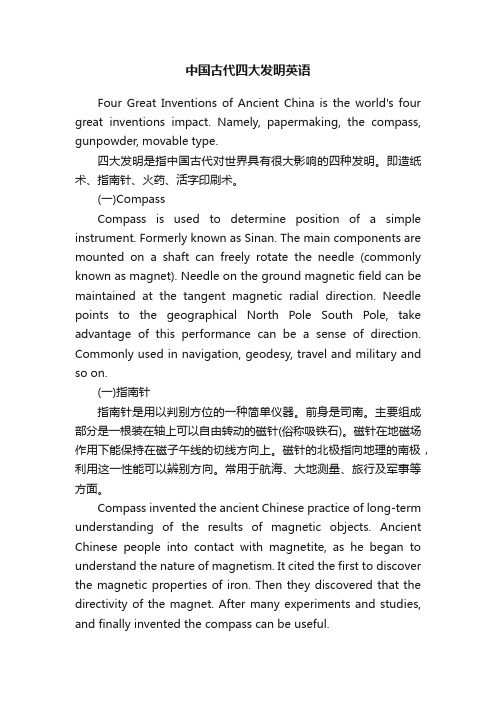
中国古代四大发明英语Four Great Inventions of Ancient China is the world's four great inventions impact. Namely, papermaking, the compass, gunpowder, movable type.四大发明是指中国古代对世界具有很大影响的四种发明。
即造纸术、指南针、火药、活字印刷术。
(一)CompassCompass is used to determine position of a simple instrument. Formerly known as Sinan. The main components are mounted on a shaft can freely rotate the needle (commonly known as magnet). Needle on the ground magnetic field can be maintained at the tangent magnetic radial direction. Needle points to the geographical North Pole South Pole, take advantage of this performance can be a sense of direction. Commonly used in navigation, geodesy, travel and military and so on.(一)指南针指南针是用以判别方位的一种简单仪器。
前身是司南。
主要组成部分是一根装在轴上可以自由转动的磁针(俗称吸铁石)。
磁针在地磁场作用下能保持在磁子午线的切线方向上。
磁针的北极指向地理的南极,利用这一性能可以辨别方向。
常用于航海、大地测量、旅行及军事等方面。
四大发明用英语介绍短文
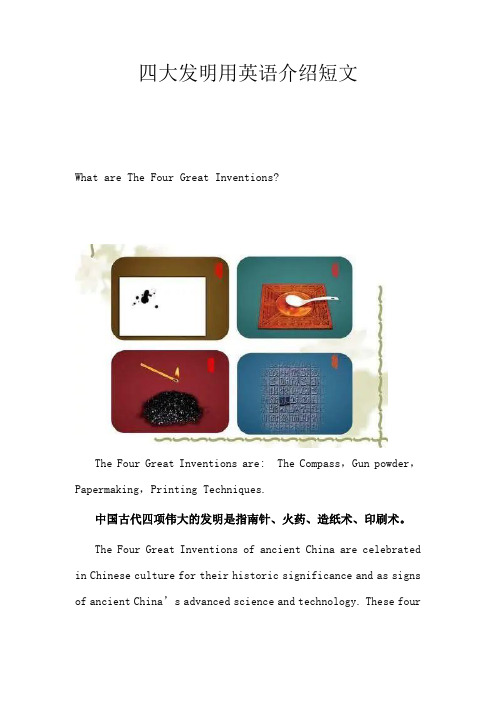
四大发明用英语介绍短文What are The Four Great Inventions?The Four Great Inventions are: The Compass,Gun powder,Papermaking,Printing Techniques.中国古代四项伟大的发明是指南针、火药、造纸术、印刷术。
The Four Great Inventions of ancient China are celebrated in Chinese culture for their historic significance and as signs of ancient China’s advanced science and technology. These fourinventions greatly promoted the development of China’s economy, politics, and culture.中国古代的四大发明因其历史意义和作为中国古代先进科学技术的标志而在中国文化中受到赞扬。
这四大发明大大促进了中国经济、政治和文化的发展。
The CompassThe history of the compass can be dated back tothe Warring States Period (476–221 BC), when Chinese people used a device calledsi nan to point the direction.指南针的历史可以追溯到战国时期(公元前476-221年),当时中国人使用一种叫做司南的装置来指明方向。
After constant improvement, a round compass with a tiny needle made of magnetized steel were invented during the early Song Dynasty. One end of the tiny needle points to the south and the other points to the north. The compass was then introduced to the Arab world and Europe during the Northern Song era (960–1127).经过不断的改进,在宋朝初期发明了一种带有磁化钢制成的小针的圆形罗盘。
四大发明(英语)
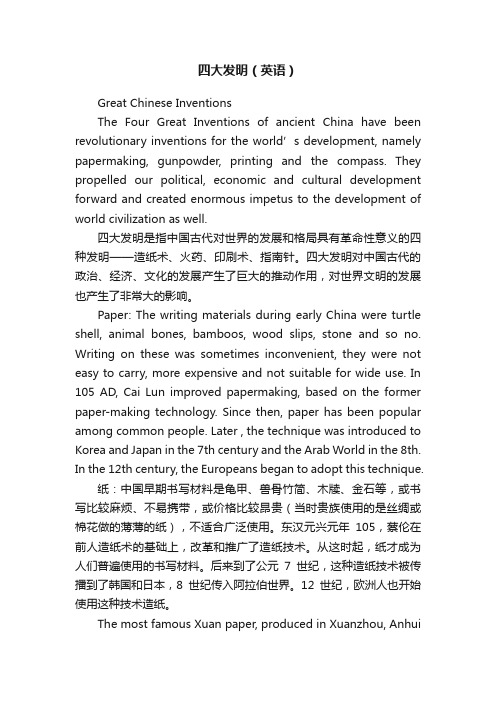
四大发明(英语)Great Chinese InventionsThe Four Great Inventions of ancient China have been revolutionary inventions for the world’s development, namely papermaking, gunpowder, printing and the compass. They propelled our political, economic and cultural development forward and created enormous impetus to the development of world civilization as well.四大发明是指中国古代对世界的发展和格局具有革命性意义的四种发明——造纸术、火药、印刷术、指南针。
四大发明对中国古代的政治、经济、文化的发展产生了巨大的推动作用,对世界文明的发展也产生了非常大的影响。
Paper: The writing materials during early China were turtle shell, animal bones, bamboos, wood slips, stone and so no. Writing on these was sometimes inconvenient, they were not easy to carry, more expensive and not suitable for wide use. In 105 AD, Cai Lun improved papermaking, based on the former paper-making technology. Since then, paper has been popular among common people. Later , the technique was introduced to Korea and Japan in the 7th century and the Arab World in the 8th. In the 12th century, the Europeans began to adopt this technique.纸:中国早期书写材料是龟甲、兽骨竹简、木牍、金石等,或书写比较麻烦、不易携带,或价格比较昂贵(当时贵族使用的是丝绸或棉花做的薄薄的纸),不适合广泛使用。
2018年12月英语四级翻译中国特色词汇:四大发明
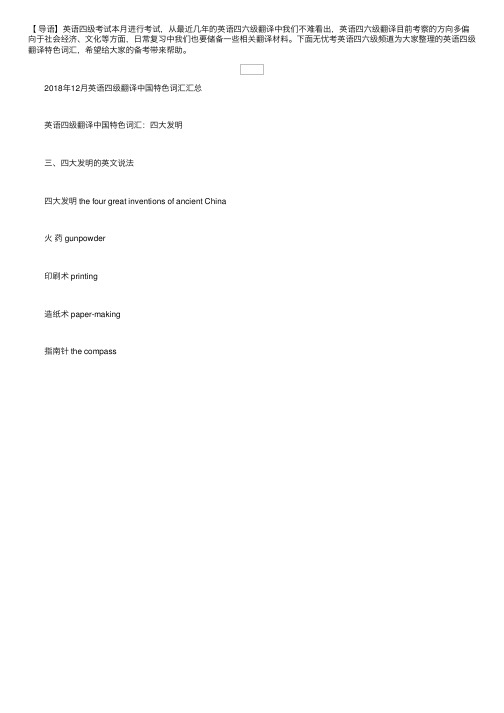
四大发明 the four great inventions of ancient China 火 药 gunpowder 印刷术 printing 造纸术 paper-making 指南针 the compass
【 导语】英语四级考试本月进行考试,从最近几年的英语四六级翻译中我们不难看出,英语四六级翻译目前考察的方向多偏 向于社会经济、文化等方面,日常复习中我们也要储备一些相关翻译材料。下面无忧考英语四六级频道为大家整理的英语四级 翻译特色词汇,希望给大家的备考带来帮助。
2018年12月英语四级翻译中国特色词汇汇总 英语四级翻译中国特色词汇:四大发明
中国古代四大发明英语

Four Great Inventions of Ancient China is the world's four great inventions impact. Namely, papermaking, the compass, gunpowder, movable type.四大发明是指中国古代对世界具有很大影响的四种发明。
即造纸术、指南针、火药、活字印刷术。
(一)CompassCompass is used to determine position of a simple instrument. Formerly known as Sinan. The main components are mounted on a shaft can freely rotate the needle (commonly known as magnet). Needle on the ground magnetic field can be maintained at the tangent magnetic radial direction. Needle points to the geographical North Pole South Pole, take advantage of this performance can be a sense of direction. Commonly used in navigation, geodesy, travel and military and so on.(一)指南针指南针是用以判别方位的一种简单仪器。
前身是司南。
主要组成部分是一根装在轴上可以自由转动的磁针(俗称吸铁石)。
磁针在地磁场作用下能保持在磁子午线的切线方向上。
磁针的北极指向地理的南极,利用这一性能可以辨别方向。
常用于航海、大地测量、旅行及军事等方面。
Compass invented the ancient Chinese practice of long-term understanding of the results of magnetic objects. Ancient Chinesepeople into contact with magnetite, as he began to understand the nature of magnetism. It cited the first to discover the magnetic properties of iron. Then they discovered that the directivity of the magnet. After many experiments and studies, and finally invented the compass can be useful.指南针的发明是中国古人在长期的实践中对物体磁性认识的结果。
四大发明简介(中英文版本)
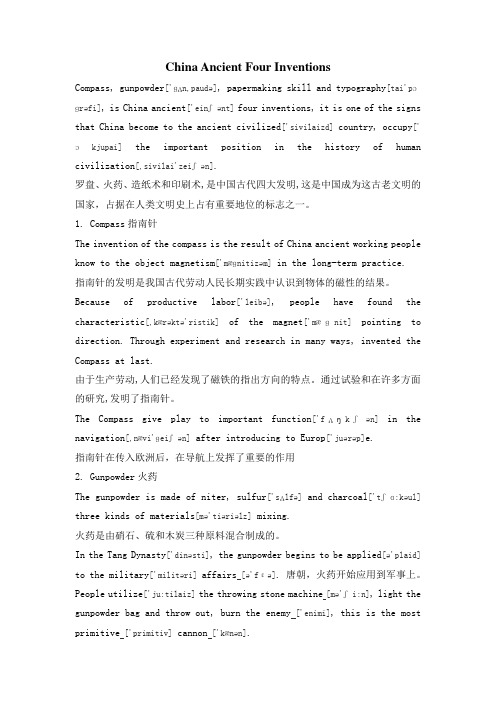
China Ancient Four InventionsCompass, gunpowder['ɡʌn,paudə], papermaking skill and typography[tai'pɔɡrəfi], is China ancient['einʃənt]four inventions, it is one of the signs that China become to the ancient civilized['sivilaizd] country, occupy['ɔkjupai]the important position in the history of human civilization[,sivilai'zeiʃən].罗盘、火药、造纸术和印刷术,是中国古代四大发明,这是中国成为这古老文明的国家,占据在人类文明史上占有重要地位的标志之一。
1. Compass指南针The invention of the compass is the result of China ancient working people know to the object magnetism['mæɡnitizəm] in the long-term practice.指南针的发明是我国古代劳动人民长期实践中认识到物体的磁性的结果。
Because of productive labor['leibə], people have found the characteristic[,kærəktə'ristik]of the magnet['mæɡnit]pointing to direction. Through experiment and research in many ways, invented the Compass at last.由于生产劳动,人们已经发现了磁铁的指出方向的特点。
thegreatfourinventions(四大发明)
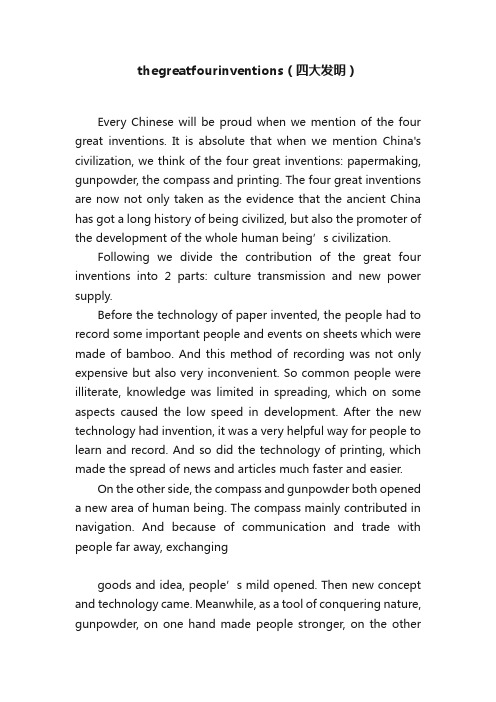
thegreatfourinventions(四大发明)Every Chinese will be proud when we mention of the four great inventions. It is absolute that when we mention China's civilization, we think of the four great inventions: papermaking, gunpowder, the compass and printing. The four great inventions are now not only taken as the evidence that the ancient China has got a long history of being civilized, but also the promoter of the development of the whole human being’s civilization.Following we divide the contribution of the great four inventions into 2 parts: culture transmission and new power supply.Before the technology of paper invented, the people had to record some important people and events on sheets which were made of bamboo. And this method of recording was not only expensive but also very inconvenient. So common people were illiterate, knowledge was limited in spreading, which on some aspects caused the low speed in development. After the new technology had invention, it was a very helpful way for people to learn and record. And so did the technology of printing, which made the spread of news and articles much faster and easier.On the other side, the compass and gunpowder both opened a new area of human being. The compass mainly contributed in navigation. And because of communication and trade with people far away, exchanginggoods and idea, people’s mild opened. Then new concept and technology came. Meanwhile, as a tool of conquering nature, gunpowder, on one hand made people stronger, on the otherhand it brought a new century of war or fighting. The war of cold-weapon finished, and a war of high technology came.In a word, the four great inventions have had an immeasurable impact on the development of world culture, military affairs, and communication and transportation.。
英文写作: 中华传统文化之四大发明
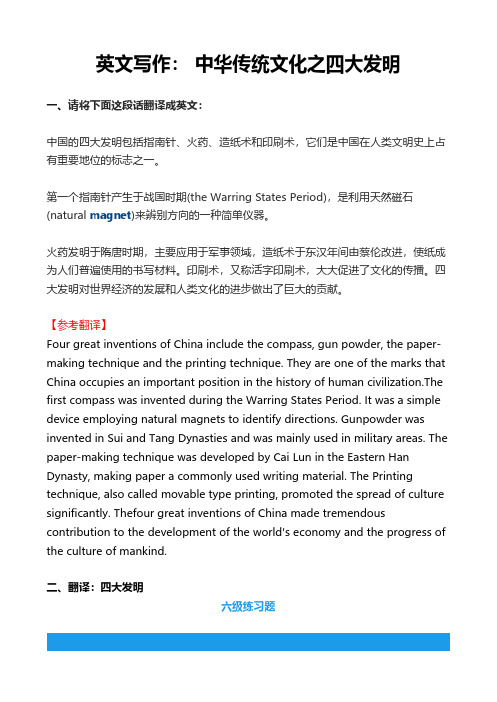
英文写作: 中华传统文化之四大发明一、请将下面这段话翻译成英文:中国的四大发明包括指南针、火药、造纸术和印刷术,它们是中国在人类文明史上占有重要地位的标志之一。
第一个指南针产生于战国时期(the Warring States Period),是利用天然磁石(natural magnet)来辨别方向的一种简单仪器。
火药发明于隋唐时期,主要应用于军事领域,造纸术于东汉年间由蔡伦改进,使纸成为人们普遍使用的书写材料。
印刷术,又称活字印刷术,大大促进了文化的传播。
四大发明对世界经济的发展和人类文化的进步做出了巨大的贡献。
【参考翻译】Four great inventions of China include the compass, gun powder, the paper-making technique and the printing technique. They are one of the marks that China occupies an important position in the history of human civilization.The first compass was invented during the Warring States Period. It was a simple device employing natural magnets to identify directions. Gunpowder was invented in Sui and Tang Dynasties and was mainly used in military areas. The paper-making technique was developed by Cai Lun in the Eastern Han Dynasty, making paper a commonly used writing material. The Printing technique, also called movable type printing, promoted the spread of culture significantly. Thefour great inventions of China made tremendous contribution to the development of the world's economy and the progress of the culture of mankind.二、翻译:四大发明六级练习题(2013年12月卷四)中国以引进新的方式方法来改变人类的生活而著称。
中国古代四大发明中英文版

Papermaking
Printing
Gunpowder
Compass
1、PAPERMAKING
When the paper appeared? What is to be made of?
First paper appeared at Xi'an in the Western Han Dynasty, and it made by oakum . In 1986, a tomb in Tianshui of Gansu Province unearthed a paper map. According to appraisal of some experts ,this piece of paper is a plant fiber paper. 最早的纸出现在西汉时期的西安,是用麻絮来制成的。 1986年,在甘肃省天水的一座古墓中 出土了一幅纸地图。经专家鉴定, 认为西汉时期的纸属于植物纤维纸。
The earliest books are copied by hand, but then it is also timeconsuming and error-prone. Therefore, printing generated .
印刷术是怎么样产生的? 最早的书籍是用手来抄写的,但是这样既费时费力也容易出错。因此就产生的
region. 12th century, spread to Europe, Africa.
造纸术对外流传 公元4世纪,传入朝鲜、越南。 公元7世纪,传入日本、阿拉伯地区。 公元12世纪,传入欧洲、非洲。
2、PRINTING
四大发明英文版
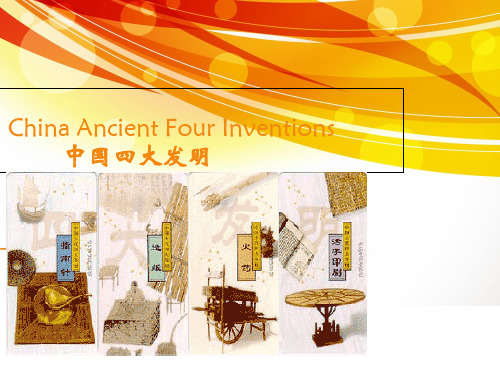
PAPERMAKING
The oldest paper Fang matan Paper
History
Paper-making is one of the four great inventions of China, the paper is the han long experience accumulation and the crystallization of the wisdom of working people, human a brilliant invention in the history of civilization.
It's.....
Magnetic compass is a device used to determine geographic direction,usually consisting of a magnetic needle or needles horizontally mounted and free to pivot until aligned with the magnetic field of Earth.
blocks, and then
characters
were
engraved in relief on the
blocks.
Ink was brushed on the engraved block and a white sheet of paper was spread across it and then brushed with a clean brush on its back leaving
By CAI lun in eastern han dynasty (105) of the first year of yuan xing papermaking, improved by CAI lun in the bark, hemp heads and our raw materials such as cloth, fishing nets, after falling, dao, copy paper, drying technology, manufacturing, is the origin of modern paper. This paper, the raw material is easy to find and very cheap, quality is also improved, gradually widely used. In honour of the feat, CAI lun later generations called this paper "Cai Hou paper"
四大发明英文
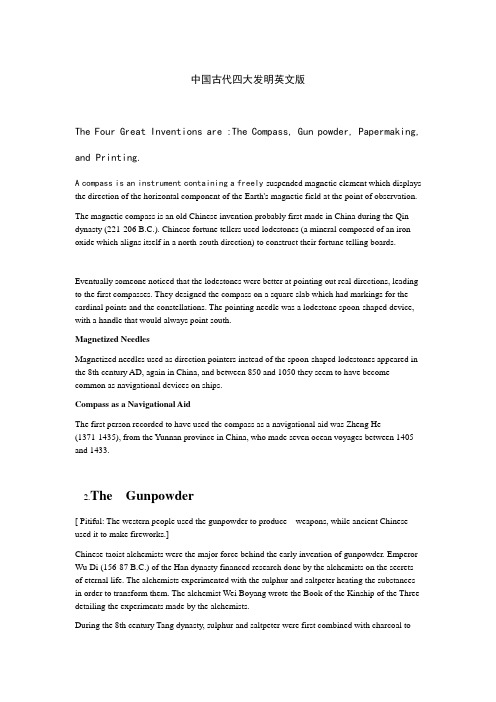
中国古代四大发明英文版The Four Great Inventions are :The Compass, Gun powder, Papermaking, and Printing.A compass is an instrument containing a freely suspended magnetic element which displays the direction of the horizontal component of the Earth's magnetic field at the point of observation.The magnetic compass is an old Chinese invention probably first made in China during the Qin dynasty (221-206 B.C.). Chinese fortune tellers used lodestones (a mineral composed of an iron oxide which aligns itself in a north-south direction) to construct their fortune telling boards.Eventually someone noticed that the lodestones were better at pointing out real directions, leading to the first compasses. They designed the compass on a square slab which had markings for the cardinal points and the constellations. The pointing needle was a lodestone spoon-shaped device, with a handle that would always point south.Magnetized NeedlesMagnetized needles used as direction pointers instead of the spoon-shaped lodestones appeared in the 8th century AD, again in China, and between 850 and 1050 they seem to have become common as navigational devices on ships.Compass as a Navigational AidThe first person recorded to have used the compass as a navigational aid was Zheng He(1371-1435), from the Yunnan province in China, who made seven ocean voyages between 1405 and 1433.2.The Gunpowder[ Pitiful: The western people used the gunpowder to produce weapons, while ancient Chinese used it to make fireworks.]Chinese taoist alchemists were the major force behind the early invention of gunpowder. Emperor Wu Di (156-87 B.C.) of the Han dynasty financed research done by the alchemists on the secretsof eternal life. The alchemists experimented with the sulphur and saltpeter heating the substances in order to transform them. The alchemist Wei Boyang wrote the Book of the Kinship of the Three detailing the experiments made by the alchemists.During the 8th century Tang dynasty, sulphur and saltpeter were first combined with charcoal tocreate an explosive called huoyao or gunpowder. A substance that did not encourage eternal life, however, gunpowder was used to treat skin diseases and as a fumigant to kill insects before its advantage as a weapon was made clear.The Chinese began experimenting with the gunpowder filled tubes. At some point, they attached bamboo tubes to arrows and launched them with bows. Soon they discovered that these gunpowder tubes could launch themselves just by the power produced from the escaping gas. The true rocket was born.3.The papermakingThe word paper is derived from the name of the reedy plant papyrus, which grows abundantly along the Nile River in Egypt. However, true paper is made of pulped cellulose fibers like wood, cotton or flax.First There Was PapyrusPapyrus is made from the sliced sections of the flower stem of the papyrus plant, pressed together and dried, and then used from writing or drawing. Papyrus appeared in Egypt around 2400 B.C.Then There Was PaperA courtier named Ts'ai-Lun, from Lei-yang in China, was the first recorded inventor of paper circa 105 A.D. Ts'ai-Lun presented paper and a papermaking process to the Chinese Emperor and that was noted in the imperial court records. There may have been papermaking in China earlier than the above date, but inventor Ts'ai-Lun did much for the spread of papermaking technology in China.Chinese PapermakingThe ancient Chinese first made paper in the following fashion.∙ Plant fibers such as hemp were soaked and beaten into a sludge∙ The sludge was strained through a cloth sieve attached to a frame that also served as adrying platform for the resulting paperNewsprintCharles Fenerty of Halifax made the first paper from wood pulp (newsprint) in 1838. Charles Fenerty was helping a local paper mill maintain an adequate supply of rags to make paper, when he succeeded in making paper from wood pulp. He neglected to patent his invention and others did patent papermaking processes based on wood fiber.Corrugated Papermaking - CardboardIn 1856, Englishmen, Healey and Allen, received a patent for the first corrugated or pleated paper. The paper was used to line men's tall hats.American, Robert Gair promptly invented the corrugated cardboard box in 1870. These werepre-cut flat pieces manufactured in bulk that opened up and folded into boxes.On December 20, 1871, Albert Jones of New York NY, patented a stronger corrugated paper (cardboard) used as a shipping material for bottles and glass lanterns.In 1874, G. Smyth built the first single sided corrugated board-making machine. Also in 1874, Oliver Long improved upon the Jones patent and invented a lined corrugated cardboard.Paper BagsThe first recorded historical reference to grocery paper bags was made in 1630. The use of paper sacks only really started to take off during the Industrial Revolution: between 1700 and 1800.Margaret Knight (1838-1914) was an employee in a paper bag factory when she invented a new machine part to make square bottoms for paper bags. Paper bags had been more like envelopes before. Knight can be considered the mother of the grocery bag, she founded the Eastern Paper Bag Company in 1870.On February 20, 1872, Luther Crowell also patented a machine that manufactured paper bags.Paper PlatesPaper foodservice disposables products were first made at the beginning of the 20th century. The paper plate was the first single-use foodservice product invented in 1904.Dixie CupsHugh Moore was an inventor who owned a paper cup factory, located next door to the Dixie Doll Company. The word Dixie was printed on the doll company's front door. Moore saw the word everyday, which reminded him of "dixies," the ten dollar bank notes from a New Orleans' bank that had the French word "dix' printed on the face of the bill. The bank had a great reputation in the early 1800s. Moore decided that "dixies" was a great name. After getting permission from his neighbor to use the name, he renamed his paper cups "Dixie Cups". It should be mentioned that Moore's paper cups first invented in 1908 were originally called health cups and replaced the single repeat-use metal cup that had been used with water fountains.4.The printingThe Chinese invention of Woodblock Printing, at some point before the first dated book in 868(theDiamond Sutra)金刚经, produced the world's first print culture. However, it is suspected in western world that book printing may have occurred long before this date.Before Gutenberg, printing was limited in the number of editions made and nearly exclusively decorative, used for pictures and designs. The material to be printed was carved into wood, stone, and metal, rolled with ink or paint and transferred by pressure to parchment or vellum. Books were hand copied mostly by members of religious orders.Johannes GutenbergJohannes Gutenberg was a German craftsman and inventor. Gutenberg is best known for the Gutenberg press, an innovative printing press machine that used movable type. It remained the standard until the 20th century. Gutenberg made printing cheap.[ Johannes Gutenberg and the History of Printing Press]Printing ProcessesLinotype & Ottmar MergenthalerOttmar Mergenthaler's invention of the linotype composing machine in 1886 is regarded as the greatest advance in printing since the development of moveable type 400 years earlier.TeletypesetterTeletypesetter, device for setting type by telegraph developed by F.E. Gannett of Rochester, N.Y., W.W. Morey of East Orange, N.J., and Morkrum-Kleinschmidt Company, Chicago, Ill. The first demo of Walter Morey's "Teletypesetter" took place in Rochester, New york in 1928.PhototypesettingLouis Marius Moyroud and Rene Alphonse Higonnet developed the first practical phototypesetting machine. The phototypesetter that used a strobe light and a series of optics to project characters from a spinning disk onto photographic paper.Silk Screening or SerigraphyIn 1907, Samuel Simon of Manchester England was awarded a patent for the process of using silk fabric as a printing screen. Using materials other than silk for screen printing has a long history that begins with the ancient art of stenciling used by the Egyptians and Greeks as early as 2500 B.C. A few years after Simon's patent, John Pilsworth of San Francisco developed a multicolor process of silk screening called screen printing. The term "Serigraphy", comes from the Latin word "Seri" (silk) and the Greek word "graphein" (to write or draw).NewspapersOne of the earliest newspapers was the Roman Acta Diurna said to have been started by Julius Caesar.。
中国古代四大发明
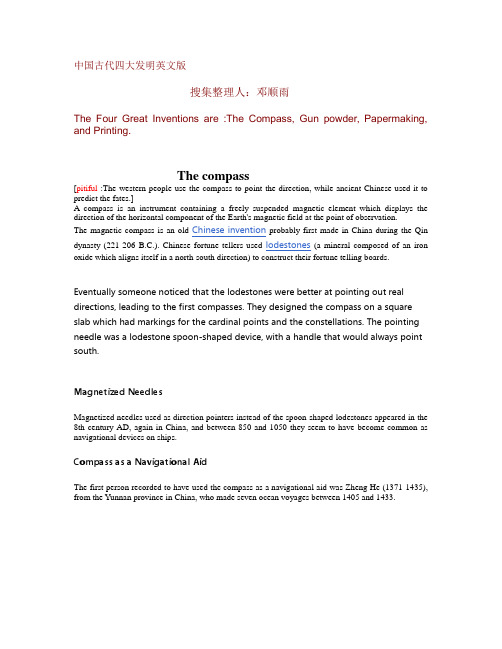
中国古代四大发明英文版搜集整理人:邓顺雨The Four Great Inventions are :The Compass, Gun powder, Papermaking, and Printing.The compass[pitiful:The western people use the compass to point the direction, while ancient Chinese used it to predict the fates.]A compass is an instrument containing a freely suspended magnetic element which displays theThe magnetic compass is an made in China during the Qin dynasty (221-206 B.C.). (a mineral composed of an ironEventually someone noticed that the lodestones were better at pointing out real directions, leading to the first compasses. They designed the compass on a square slab which had markings for the cardinal points and the constellations. The pointing needle was a lodestone spoon-shaped device, with a handle that would always point south.Magnetized NeedlesMagnetized needles used as direction pointers instead of the spoon-shaped lodestones appeared in the 8th century AD, again in China, and between 850 and 1050 they seem to have become common as navigational devices on ships.Compass as a Navigational AidThe first person recorded to have used the compass as a navigational aid was Zheng He (1371-1435), from the Y unnan province in China, who made seven ocean voyages between 1405 and 1433.The Gunpowder[ Pitiful: The western people used the gunpowder to produce the weapons, while ancient Chinese used it to make fireworks.]Chinese taoist alchemists were the major force behind the early invention of gunpowder. Emperor Wu Di (156-87 B.C.) of the Han dynasty financed research done by the alchemists on the secrets of eternal life. The alchemists experimented with the sulphur and saltpeter heating the substances in order to transform them. The alchemist Wei Boyang wrote the Book of the Kinship of the Three detailing the experiments made by the alchemists.During the 8th century T ang dynasty, sulphur and saltpeter were first combined with charcoal to create an explosive called huoyao or gunpowder. A substance that did not encourage eternal life, however, gunpowder was used to treat skin diseases and as a fumigant to kill insects before its advantage as a weapon was made clear.The Chinese began experimenting with the gunpowder filled tubes. At some point, they attached bamboo tubes to arrows and launched them with bows. Soon they discovered that these gunpowder tubes could launch themselves just by the power produced from the escaping gas. The true rocket was born.The papermakingThe word paper is derived from the name of the reedy plant papyrus, which grows abundantly along the Nile River in Egypt. However, true paper is made of pulped cellulose fibers like wood, cotton or flax.First There Was PapyrusPapyrus is made from the sliced sections of the flower stem of the papyrus plant, pressed together and dried, and then used from writing or drawing. Papyrus appeared in Egypt around 2400 B.C.Then There Was PaperA courtier named Ts'ai-Lun, from Lei-yang in China, was the first recorded inventor of paper circa 105 A.D. Ts'ai-Lun presented paper and a papermaking process to the Chinese Emperor and that was noted in the imperial court records. There may have been papermaking in China earlier than the above date, but inventor Ts'ai-Lun did much for the spread of papermaking technology in China.Chinese PapermakingThe ancient Chinese first made paper in the following fashion.∙Plant fibers such as hemp were soaked and beaten into a sludge∙The sludge was strained through a cloth sieve attached to a frame that also served as a drying platform for the resulting paperNewsprintCharles Fenerty of Halifax made the first paper from wood pulp (newsprint) in 1838. Charles Fenerty was helping a local paper mill maintain an adequate supply of rags to make paper, when he succeeded in making paper from wood pulp. He neglected to patent his invention and others did patent papermaking processes based on wood fiber.Corrugated Papermaking - CardboardIn 1856, Englishmen, Healey and Allen, received a patent for the first corrugated or pleated paper. The paper was used to line men's tall hats.American, Robert Gair promptly invented the corrugated cardboard box in 1870. These were pre-cut flat pieces manufactured in bulk that opened up and folded into boxes.On December 20, 1871, Albert Jones of New York NY, patented a stronger corrugated paper (cardboard) used as a shipping material for bottles and glass lanterns.In 1874, G. Smyth built the first single sided corrugated board-making machine. Also in 1874, Oliver Long improved upon the Jones patent and invented a lined corrugated cardboard.Paper BagsThe first recorded historical reference to grocery paper bags was made in 1630. The use of paper sacks only really started to take off during the Industrial Revolution: between 1700 and 1800.Margaret Knight (1838-1914) was an employee in a paper bag factory when she invented a new machine part to make square bottoms for paper bags. Paper bags had been more like envelopes before. Knight can be considered the mother of the grocery bag, she founded the Eastern Paper Bag Company in 1870.On February 20, 1872, Luther Crowell also patented a machine that manufactured paper bags.Paper PlatesPaper foodservice disposables products were first made at the beginning of the 20th century. The paper plate was the first single-use foodservice product invented in 1904.Dixie CupsHugh Moore was an inventor who owned a paper cup factory, located next door to the Dixie Doll Company. The word Dixie was printed on the doll company's front door. Moore saw the word everyday, which reminded him of "dixies," the ten dollar bank notes from a New Orleans' bank that had the French word "dix' printed on the face of the bill. The bank had a great reputation in the early 1800s. Moore decided that "dixies" was a great name. After getting permission from his neighbor to use the name, he renamed his paper cups "Dixie Cups". It should be mentioned that Moore's paper cups first invented in 1908 were originally called health cups and replaced the single repeat-use metal cup that had been used with water fountains.The printingThe Chinese invention of Woodblock Printing, at some point before the first dated book in 868(the Diamond Sutra)金刚经, produced the world's first print culture. However, it is suspected in western world that book printing may have occurred long before this date.。
中国四大发明(英文版)

Four Great Inventions四大发明Four great inventions: the compass, gunpowder, paper and movable type printing, were ancient China’s outstanding scientific and technological contributions to world civilization.The Compass罗盘The world’s first compass was made in China during the Warring States Period (475-221 B.C. ) by balancing a piece of lodestone carved in the shape of a ladle on a smooth, flat plate and letting it spin. When it stopped, the handle always pointed to the south. After the Northern Song Dynasty (A.D. 960-1127) the Chinese people connected the compass with a square plate engraved with directional points, thus creating the basis for the compasses of today.The compass give play to important function in the navigation after introducing to Europe.Gunpowder火药The Chinese people invented gunpowder in the 7th century. After the invention of gunpowder, human beings suddenly had an unprecedented great force. At the end of the Tang Dynasty and the beginning of the Song Dynasty (10th century), gunpowder began tobe used in weapons. From 1225 to 1248, gunpowder and firearms were introduced to Arab countries from India, and then taken to European countries from Arab regions.Paper造纸Cai Lun, who lived during the Eastern Han Dynasty (25-220), produced high quality paper using tree bark, remnants of hemp, linen rags and other materials. The invention of Cai Lun’s paper-making technique marked the ripening of China’s paper-making technique, and meanwhile enabled the people to leave behind them the days of writing on bamboo slips and cotton cloth.China’s paper-making technology was introduced to Korea and Japan in the 7th century, taken to Arab countries from Central Asia and eventually to European countries during the 12th to 16th centuries. China’s paper-making technology played a great role in the European Renaissance and other cultural and scientific undertaking of the world.Printing印刷术The typography is one of the most important four inventions in ancient China.The invention of China’s printing technique went through twostages, block printing and movable-type printing. BI Sheng’s movable-type printing was introduced to Korea and Japan in the 8th century, and then to Arabia and Europe in the 12th century. Main Religion and philosophy宗教和哲学In China, different religions are respected. People have their own right to choose their belief in God or Allah or in others. people believing in different religions live happily together.gift•Gift giving is a big part of any culture. China is no exception.There are sth interesting in gift giving in China.•For example,Do not give knives, scissors, letter openers, etc. It implies thesevering of a relationshipDo not expect that a gift will be opened immediatelyAvoid giving things to people in groups of four, since thenumber four in Chinese is a homonym for the word 'death' .Never give a Chinese gentleman a green hat. It is associatedwith adultery.Do not give aged people a clock. It is a homonym for the word ‘death’.。
- 1、下载文档前请自行甄别文档内容的完整性,平台不提供额外的编辑、内容补充、找答案等附加服务。
- 2、"仅部分预览"的文档,不可在线预览部分如存在完整性等问题,可反馈申请退款(可完整预览的文档不适用该条件!)。
- 3、如文档侵犯您的权益,请联系客服反馈,我们会尽快为您处理(人工客服工作时间:9:00-18:30)。
Good science
PAPERMAKING
The oldest paper Fang matan Paper
History
Paper-making is one of the four great inventions of China, the paper is the han long experience accumulation and the crystallization of the wisdom of working people, human a brilliant invention in the history of civilization. China is the world's earliest sericulture silk in the world. Han Chinese working people above cocoon silk silk, such as the remaining evil cocoon, cocoon disease such as flocculant with legal system take silk floss. After floating flocculant, woven bamboo mat legacy will be some residual effect. When the number of floating flocculant, woven bamboo mat on the residual flocculant product into a layer of fiber sheet, after dry stripping down, can be used for writing. This flocculant floating there aren't many by-products, and call it HeTi or FangXu on ancient book.
The fourth is dry, namely the wet paper to dry or dry, peeling the became a paper.
The design of the papermaking process
The spread of papermaking
Research shows that this technology spread to many countries even the world . First of all incoming and papermaking in China and Vietnam, followed by adjacent spread to Korea, Japan, is along the Tang Dynasty - Arab - the spread of this line in Europe. Moreover in many countries paper is used for money so this technology helps their economic thus it led a number of economic development.
Consequences
Especially during the Ming Dynasty, Zheng He made expeditions to Southeast Asia for seven times with more than 27000 people and dozens of big ships each time, which contributes to the extension and development of seafaring and foreign trade in the world
By CAI lun in eastern han dynasty (105) of the first year of yuan xing papermaking, improved by CAI lun in the bark, hemp heads and our raw materials such as cloth, fishing nets, after falling, dao, copy paper, drying technology, manufacturing, is the origin of modern paper. This paper, the raw material is easy to find and very cheap, quality is also improved, gradually widely used. In honour of the feat, CAI lun later generations called this paper "Cai Hou paper"
China Ancient Four Inventions 中国四大发明
Magnetic
Compass
It's.....
Through the ages, China is considered to be the first country that invented and used magnetic compass.Nearly two thousand years have passed since our ancestors invented compass.
Printing, known as
“mother of civilization”, was another great invention of the Chinese people. It has history includes a long and
block printing (雕版印刷) and movable type printing ( 活 字 印 刷 ).
You can say that, the reason why seafaring can develop rapidly in modern times is because it benefits from the invention and application of magnetic compass.
Block printing (雕版印刷)
Block Printing was probably invented between the Sui and Tang dynasties. The process of block printing started with the cutting of wood into blocks, and then characters were engraved in relief on the blocks. Ink was brushed on the engraved block and a white sheet of paper was spread across it and then brushed with a clean brush on its back leaving an image when
Consequences
It has a big influence on military, economy, seafaring; it pushes forward the great discoveries of geography. Without magnetic compass, Columbus couldn't arrived new continent; China is still adopting a policy of seclusion and comes to a standstill.
Effect
In the word paper is the crystallization of labor and knowledge, it helps people study, remember information and do some cleaning and so on. Paper is a bridge to heritage cultural of mankind. It is a witness of the great civilization and the famous thought. It is the direct teacher of human developed. It is an essential assistant to human life.
Importance
From simply using it to find direction and judge fengshui to magnetic compass being used in world navigation, till today, various newly-invented magnetic compasses are applied broadly.
Good science
China's ancient science and technology was once brilliant, which bring us great hoБайду номын сангаасor. The spread and application of magnetic compass in western countries urge us to have further understanding of the significance and influence of magnetic compass in the world.
Cai lun
The design of the papermaking process
